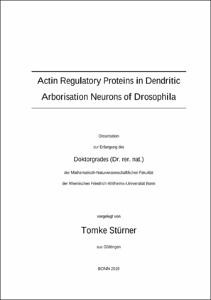Stürner, Tomke: Actin Regulatory Proteins in Dendritic Arborisation Neurons of Drosophila. - Bonn, 2019. - Dissertation, Rheinische Friedrich-Wilhelms-Universität Bonn.
Online-Ausgabe in bonndoc: https://nbn-resolving.org/urn:nbn:de:hbz:5-56242
Online-Ausgabe in bonndoc: https://nbn-resolving.org/urn:nbn:de:hbz:5-56242
@phdthesis{handle:20.500.11811/8094,
urn: https://nbn-resolving.org/urn:nbn:de:hbz:5-56242,
author = {{Tomke Stürner}},
title = {Actin Regulatory Proteins in Dendritic Arborisation Neurons of Drosophila},
school = {Rheinische Friedrich-Wilhelms-Universität Bonn},
year = 2019,
month = oct,
note = {Dendrites are highly branched extensions of nerve cells, along which signals are received and propagated to the cell body. The correct morphology of dendrites is essential for the function of the nervous system. The underlying cytoskeleton defining the shape and dynamic rearrangement of dendritic branches is under the control of complex protein networks. The aim of this study is to elucidate how these regulators of the actin cytoskeleton define the diverse characteristic shapes and dynamics of dendritic trees.
Investigating the differentiation of Drosophila larva dendritic arborisation (da) neurons, I demonstrated that the WASP-family verprolin homologous protein (WAVE) through the recruitment of the Arp2/3 complex promotes the formation of a branched actin patch at the base of a newly forming branchlet. Initiated by the GTPase Rac1, the Arp2/3 complex is essential for branch formation in all classes of da neurons. To elucidate the mechanisms of actin organization following this initial step, I questioned whether additional actin cytoskeletal proteins are required for branching in these neurons. For this I concentrated on the class III da (c3da) neurons and characterised their dendrite morphology focusing on the actin enriched small terminal branchlets (TB). These actin enriched branches stay dynamic throughout larval stages making them a good model system to study actin dependent dendrite dynamics. I investigated the role of several actin regulatory proteins (ARP) that had published functions in c3da neurons and ones that I had previous indications that they might play a role in c3da neurons. A new comparative computational approach to in vivo mutant analysis allowed me to analyse the dendritic phenotypes further and correlate them with the biochemical function. This enabled me to position them in the context of branch dynamics. In addition, this approach uncovered which parameter alterations the different ARP mutants influence, specifically in the dendritic trees of c3da neurons. I focus on the actin nucleators Arp2/3, Spire and Capu/Formin2, the bundling factor Singed/Fascin the actin binding protein Ena/VASP and the severing and depolymerisation factor Twinstar/Cofilin. Mutants of the different actin regulators all show reduced number of branches in c3da neurons which was previously described for singed, ena, twinstar. Furthermore, I demonstrate here that they all have diverse dendritic tree morphologies. I developed new quantification methods in the “Trees Toolbox” (http://www.treestoolbox.org/) in Matlab and probed 28 different dendrite parameters and thus was able to quantitatively resolve the modified dendrite morphologies and thus revealed new mechanistic aspects of these ARPs during dendrite branching. Moreover, by combining this with in vivo time-lapse imaging I described the interplay of ARPs and uncovered how these ARPs regulate different aspects of branch dynamics in these c3da neurons.},
url = {https://hdl.handle.net/20.500.11811/8094}
}
urn: https://nbn-resolving.org/urn:nbn:de:hbz:5-56242,
author = {{Tomke Stürner}},
title = {Actin Regulatory Proteins in Dendritic Arborisation Neurons of Drosophila},
school = {Rheinische Friedrich-Wilhelms-Universität Bonn},
year = 2019,
month = oct,
note = {Dendrites are highly branched extensions of nerve cells, along which signals are received and propagated to the cell body. The correct morphology of dendrites is essential for the function of the nervous system. The underlying cytoskeleton defining the shape and dynamic rearrangement of dendritic branches is under the control of complex protein networks. The aim of this study is to elucidate how these regulators of the actin cytoskeleton define the diverse characteristic shapes and dynamics of dendritic trees.
Investigating the differentiation of Drosophila larva dendritic arborisation (da) neurons, I demonstrated that the WASP-family verprolin homologous protein (WAVE) through the recruitment of the Arp2/3 complex promotes the formation of a branched actin patch at the base of a newly forming branchlet. Initiated by the GTPase Rac1, the Arp2/3 complex is essential for branch formation in all classes of da neurons. To elucidate the mechanisms of actin organization following this initial step, I questioned whether additional actin cytoskeletal proteins are required for branching in these neurons. For this I concentrated on the class III da (c3da) neurons and characterised their dendrite morphology focusing on the actin enriched small terminal branchlets (TB). These actin enriched branches stay dynamic throughout larval stages making them a good model system to study actin dependent dendrite dynamics. I investigated the role of several actin regulatory proteins (ARP) that had published functions in c3da neurons and ones that I had previous indications that they might play a role in c3da neurons. A new comparative computational approach to in vivo mutant analysis allowed me to analyse the dendritic phenotypes further and correlate them with the biochemical function. This enabled me to position them in the context of branch dynamics. In addition, this approach uncovered which parameter alterations the different ARP mutants influence, specifically in the dendritic trees of c3da neurons. I focus on the actin nucleators Arp2/3, Spire and Capu/Formin2, the bundling factor Singed/Fascin the actin binding protein Ena/VASP and the severing and depolymerisation factor Twinstar/Cofilin. Mutants of the different actin regulators all show reduced number of branches in c3da neurons which was previously described for singed, ena, twinstar. Furthermore, I demonstrate here that they all have diverse dendritic tree morphologies. I developed new quantification methods in the “Trees Toolbox” (http://www.treestoolbox.org/) in Matlab and probed 28 different dendrite parameters and thus was able to quantitatively resolve the modified dendrite morphologies and thus revealed new mechanistic aspects of these ARPs during dendrite branching. Moreover, by combining this with in vivo time-lapse imaging I described the interplay of ARPs and uncovered how these ARPs regulate different aspects of branch dynamics in these c3da neurons.},
url = {https://hdl.handle.net/20.500.11811/8094}
}






